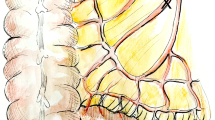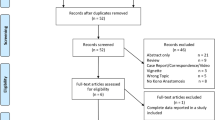Abstract
Background
Ileocolic anastomosis is an essential step in the treatment to restore continuity of the gastrointestinal tract following ileocolic resection in patients with Crohn’s disease (CD). However, the association between anastomotic type and surgical outcome is controversial.
Aims
The aim of this meta-analysis is to compare surgical outcomes between stapled side-to-side anastomosis (SSSA) and handsewn end-to-end anastomosis (HEEA) after ileocolic resection in patients with CD.
Methods
Studies comparing SSSA with HEEA after ileocolic resection in patients with CD were identified in PubMed and EMBASE. Outcomes such as complication, recurrence, and re-operation were evaluated. Eight studies (three randomized controlled trials, one prospective non-randomized trial, and four non-randomized retrospective trials) comparing SSSA (396 cases) and HEEA (425 cases) were included.
Results
As compared with HEEA, SSSA was superior in terms of overall postoperative complications [odds ratio (OR), 0.54; 95 % confidence interval (CI) 0.32–0.93], anastomotic leak (OR 0.45; 95 % CI 0.20–1.00), recurrence (OR 0.20; 95 % CI 0.07–0.55), and re-operation for recurrence (OR 0.18; 95 % CI 0.07–0.45). Postoperative hospital stay, mortality, and complications other than anastomotic leak were comparable.
Conclusion
Based on the results of our meta-analysis, SSSA would appear to be the preferred procedure after ileocolic resection for CD, with reduced overall postoperative complications, especially anastomotic leak, and a decreased recurrence and re-operation rate.



Similar content being viewed by others
References
Cosnes J, Gower-Rousseau C, Seksik P, Cortot A. Epidemiology and natural history of inflammatory bowel diseases. Gastroenterology. 2011;140:1785–1794.
Galandiuk S, Kimberling J, Al-Mishlab TG, Stromberg AJ. Perianal Crohn disease: predictors of need for permanent diversion. Ann Surg. 2005;241:796–802.
Cosnes J. Crohn’s disease phenotype, prognosis, and long-term complications: what to expect? Acta Gastroenterol Belg. 2008;71:303–307.
Choy PY, Bissett IP, Docherty JG, et al. Stapled versus handsewn methods for ileocolic anastomoses. Cochrane Database Syst Rev. 2007;(3):CD0043202011.
Myrelid P, Soderholm JD, Olaison G, Sjodahl R, Andersson P. Split stoma in resectional surgery of high-risk patients with ileocolonic Crohn’s disease. Colorectal Dis. 2012;14:188–193.
Michelassi F, Upadhyay GA. Side-to-side isoperistaltic strictureplasty in the treatment of extensive Crohn’s disease. J Surg Res. 2004;117:71–78.
Buisson A, Chevaux JB, Allen PB, Bommelaer G, Peyrin-Biroulet L. Review article: the natural history of postoperative Crohn’s disease recurrence. Aliment Pharmacol Ther. 2012;35:625–633.
Watanabe T, Sasaki I, Sugita A, et al. Time trend and risk factors for reoperation in Crohn’s disease in Japan. Hepatogastroenterology. 2012;59:1081–1086.
Gao X, Yang RP, Chen MH, et al. Risk factors for surgery and postoperative recurrence: analysis of a south China cohort with Crohn’s disease. Scand J Gastroenterol. 2012;47:1181–1191.
Li Y, Zhu W, Zuo L, et al. Frequency and risk factors of postoperative recurrence of Crohn’s disease after intestinal resection in the Chinese population. J Gastrointest Surg. 2012;16:1539–1547.
Ikeuchi H, Kusunoki M, Yamamura T. Long-term results of stapled and hand-sewn anastomoses in patients with Crohn’s disease. Dig Surg. 2000;17:493–496.
Mcleod RS, Wolff BG, Ross S, Parkes R, Mckenzie M. Recurrence of Crohn’s disease after ileocolic resection is not affected by anastomotic type: results of a multicenter, randomized, controlled trial. Dis Colon Rectum. 2009;52:919–927.
Simillis C, Purkayastha S, Yamamoto T, et al. A meta-analysis comparing conventional end-to-end anastomosis vs. other anastomotic configurations after resection in Crohn’s disease. Dis Colon Rectum. 2007;50:1674–1687.
Guo Z, Li Y, Zhu W, et al. Comparing outcomes between side-to-side anastomosis and other anastomotic configurations after intestinal resection for patients with Crohn’s disease: a meta-analysis. World J Surg. 2013;37:893–901.
Hozo SP, Djulbegovic B, Hozo I. Estimating the mean and variance from the median, range, and the size of a sample. BMC Med Res Methodol. 2005;5:13.
Jadad AR, Moore RA, Carroll D, et al. Assessing the quality of reports of randomized clinical trials: is blinding necessary? Control Clin Trials. 1996;17:1–12.
Stang A. Critical evaluation of the Newcastle–Ottawa scale for the assessment of the quality of nonrandomized studies in meta-analyses. Eur J Epidemiol. 2010;25:603–605.
Higgins JP, Thompson SG. Quantifying heterogeneity in a meta-analysis. Stat Med. 2002;21:1539–1558.
Cameron JL, Hamilton SR, Coleman J, Sitzmann JV, Bayless TM. Patterns of ileal recurrence in Crohn’s disease. A prospective randomized study. Ann Surg. 1992;215:546–552.
Caprilli R, Corrao G, Taddei G, et al. Prognostic factors for postoperative recurrence of Crohn’s disease. Gruppo Italiano per lo Studio del Colon e del Retto (GISC). Dis Colon Rectum. 1996;39:335–341.
Kusunoki M, Ikeuchi H, Yanagi H, Shoji Y, Yamamura T. A comparison of stapled and hand-sewn anastomoses in Crohn’s disease. Dig Surg. 1998;15:679–682.
Hashemi M, Novell JR, Lewis AA. Side-to-side stapled anastomosis may delay recurrence in Crohn’s disease. Dis Colon Rectum. 1998;41:1293–1296.
Yamamoto T, Keighley MR. Stapled functional end-to-end anastomosis in Crohn’s disease. Surg Today. 1999;29:679–681.
Yamamoto T, Bain IM, Mylonakis E, Allan RN, Keighley MR. Stapled functional end-to-end anastomosis versus sutured end-to-end anastomosis after ileocolonic resection in Crohn disease. Scand J Gastroenterol. 1999;34:708–713.
Yamamoto T, Allan RN, Keighley MR. Strategy for surgical management of ileocolonic anastomotic recurrence in Crohn’s disease. World J Surg. 1999;23:1055–1061.
Frieri G, Pimpo MT, Palumbo G, et al. Anastomotic configuration and mucosal 5-aminosalicyclic acid (5-ASA) concentrations in patients with Crohn’s disease: a GISC study. Gruppo Italiano per lo Studio del Colon e del Retto. Am J Gastroenterol. 2000;95:1486–1490.
Muñoz-Juárez M, Yamamoto T, Wolff BG, Keighley MR. Wide-lumen stapled anastomosis vs. conventional end-to-end anastomosis in the treatment of Crohn’s disease. Dis Colon Rectum. 2001;44:20–26.
Smedh K, Andersson M, Johansson H, Hagberg T. Preoperative management is more important than choice of sutured or stapled anastomosis in Crohn’s disease. Eur J Surg. 2002;168:154–157.
Tersigni R, Alessandroni L, Barreca M, Piovanello P, Prantera C. Does stapled functional end-to-end anastomosis affect recurrence of Crohn’s disease after ileocolonic resection? Hepatogastroenterology. 2003;50:1422–1425.
Scarpa M, Angriman I, Barollo M, et al. Role of stapled and hand-sewn anastomoses in recurrence of Crohn’s disease. Hepatogastroenterology. 2004;51:1053–1057.
Resegotti A, Astegiano M, Farina EC, et al. Side-to-side stapled anastomosis strongly reduces anastomotic leak rates in Crohn’s disease surgery. Dis Colon Rectum. 2005;48:464–468.
Scarpa M, Ruffolo C, Bertin E, et al. Surgical predictors of recurrence of Crohn’s disease after ileocolonic resection. Int J Colorectal Dis. 2007;22:1061–1069.
Zurbuchen U, Kroesen AJ, Knebel P, et al. Complications after end-to-end vs. side-to-side anastomosis in ileocecal Crohn’s disease-early postoperative results from a randomized controlled multi-center trial (ISRCTN-45665492). Langenbecks Arch Surg. 2013;398:467–474.
Scammell B, Ambrose NS, Alexander-Williams J, Allan RN, Keighley MR. Recurrent small bowel Crohn’s disease is more frequent after subtotal colectomy and ileorectal anastomosis than proctocolectomy. Dis Colon Rectum. 1985;28:770–771.
Farmer RG, Hawk WA, Turnbull RJ. Clinical patterns in Crohn’s disease: a statistical study of 615 cases. Gastroenterology. 1975;68:627–635.
Fichera A, Zoccali M, Kono T. Antimesenteric functional end-to-end handsewn (Kono-S) anastomosis. J Gastrointest Surg. 2012;16:1412–1416.
Kono T, Ashida T, Ebisawa Y, et al. A new antimesenteric functional end-to-end handsewn anastomosis: surgical prevention of anastomotic recurrence in Crohn’s disease. Dis Colon Rectum. 2011;54:586–592.
Conflict of interest
None.
Author information
Authors and Affiliations
Corresponding author
Additional information
Xiaosheng He and Zexian Chen have contributed equally to this work.
Electronic supplementary material
Below is the link to the electronic supplementary material.
Rights and permissions
About this article
Cite this article
He, X., Chen, Z., Huang, J. et al. Stapled Side-to-Side Anastomosis Might Be Better Than Handsewn End-to-End Anastomosis in Ileocolic Resection for Crohn’s Disease: A Meta-Analysis. Dig Dis Sci 59, 1544–1551 (2014). https://doi.org/10.1007/s10620-014-3039-0
Received:
Accepted:
Published:
Issue Date:
DOI: https://doi.org/10.1007/s10620-014-3039-0




